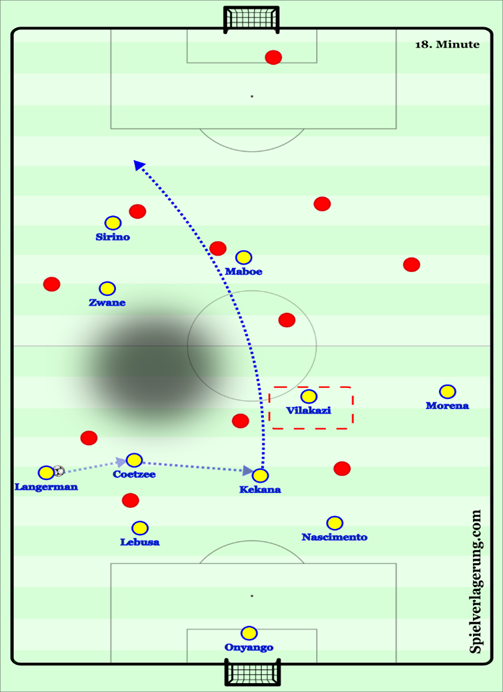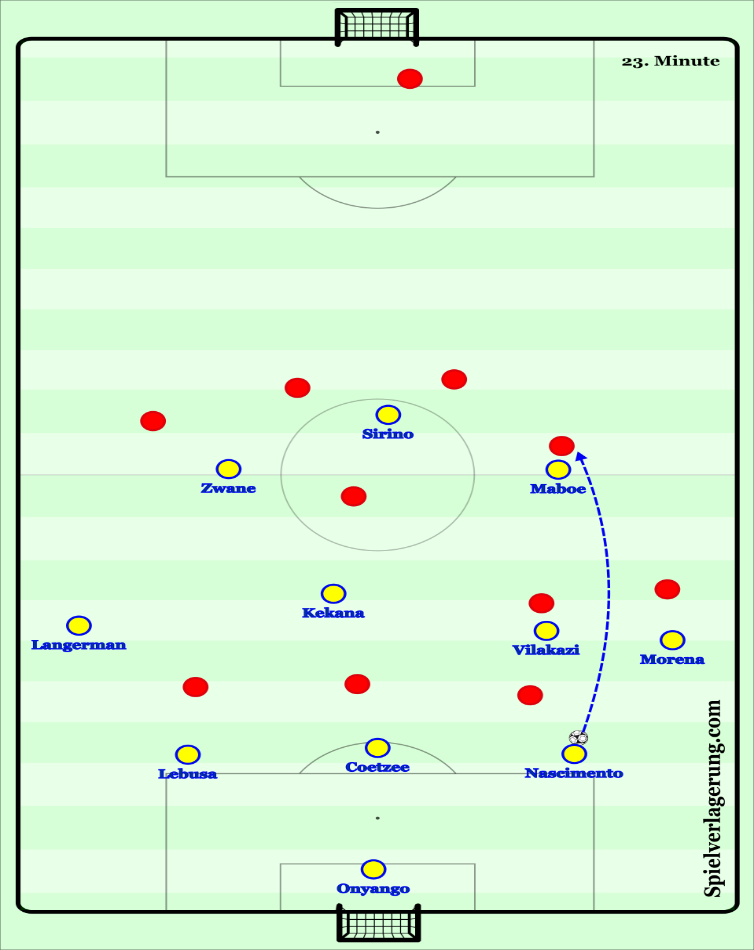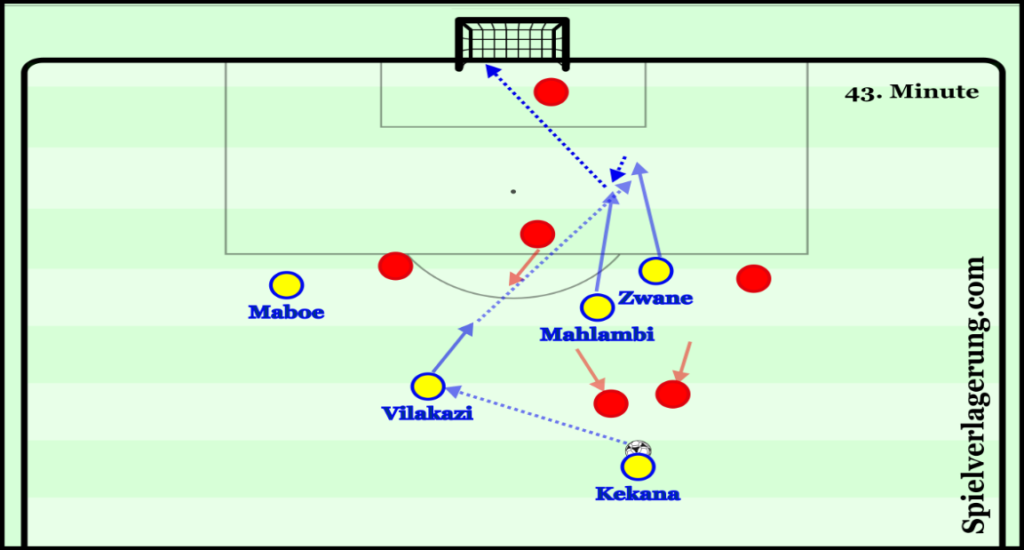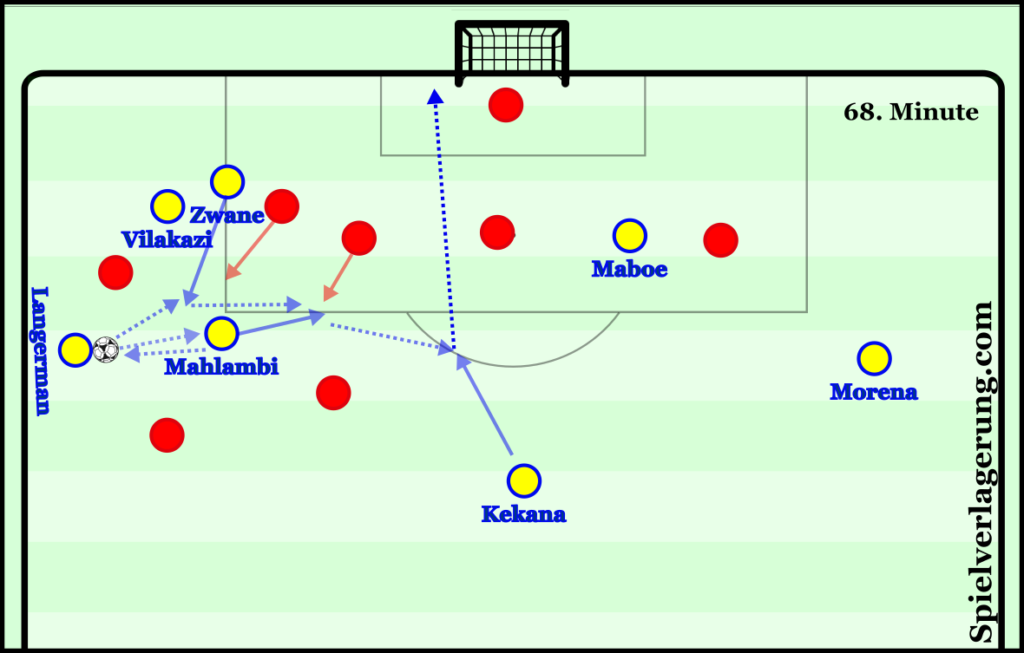Sundowns do enough to secure back to back ABSA Premiership titles
Free State Stars took on Mamelodi Sundowns in a crucial final league game in the South African ABSA Premiership. The home side badly needed a result to avoid relegation to the National First Division, while a win would secure back to back league titles for the away side.

The Pretoria based away side lined up in their standard 4-4-2/4-2-2-2 shape. This includes the use of two linear attacking oriented fullbacks in Langerman on the left and Morena on the right. The two side midfielders would look to move infield and occupy dynamic playmaking roles in the halfspaces, and occasionally dropping back slightly to provide connections.
Once the ball is in the attacking third, they would look link up and overload together with a fluid front two who roam through spaces, looking to get small localized group combinations going. The midfield two was made up of former (almost) Celtic Glasgow player Rivaldo Coetzee. Who has recently made the switch from center-back to ball circulating focused anchorman midfielder and national team veteran and captain Hlompho Kekana. Who covers a huge amount of space in a box to box role, offering a goal threat arriving from deeper positions.
The home side lined up in a 4-2-3-1 formation, with Congolese striker Harris Tchilimbou occupying the last line whilst two very vertical and dynamic wingers in Jappie on the left and Hlubi on the right would look to achieve wing breakthroughs based around quick combinations.
2-2 Buildup vs Man-oriented forward defending
The early parts of the encounter settled into a pattern of Sundowns being the team enjoying more of the ball-possession. Both fullbacks would push up high and wide, whilst the two center-backs were tasked with the initial ball progression along with Kekana and Coetzee.
Free State allowed Sundowns to play the first pass without direct pressure applied, however any forward pass from there, mostly into the two central midfielders was met with aggressive man-oriented defending. These pressing actions were often executed without much support around it, creating clear 5v4 structure in one half. This was however enough to get the Downs players to launch several long aerial balls far upfield.
If the center-backs would be in possession in between the box and the halfway line, the two central midfielders would be covered man to man. They would try to negate these moments by one of them, usually Kekana, dropping next to the center-backs which was not followed by the opposition man-marker. These dropping movements were not into a typical fullback-like positions as is more common in European football, but much closer to the actual ball carrier into more of a 3rd center back position.
This meant that Kekana would be without pressure when receiving in these situations, but also come so close to the ball that the change of ball position had very little meaningful effect on potential passing lines to players further upfield, forcing little to no adjustment from the opposition defense. Once again dribbling into space was not a frequent sight, as long balls were then launched from these areas.
Over-vertical approach causes drawn out game
A distinct feature of the South African game is its frantically vertical nature, and this game was an example of this. Despite the fact that both teams would usually look to build up on the ground in the first part of their build, vertical play largely prevalent from there on in.
When faced with slight opposition pressure, the center backs or defensive midfielders of either side would usually hit high long balls into advanced zones usually not occupied by many teammates. However, with a fair portion of players employed to perform a flat build up, the resulting possession structures can best described as 4-0-6 or 6-0-4.

This meant that there were few connections between the build up phase and the next potential ball progression through the middle third of the field. Both teams surpassed this area and focused on getting from the first to the final third directly, even when potential options were available (like Vilakazi in the above example in the red box). When both teams employ this modus operandi, the game becomes somewhat drawn out and stretched. There are were few strings of four, five or more passes.
It is common to find that players attempt to be over impactful when in possession the ball. With a far lower average of passes and touches per player per game, it is common to see ABSA premiership footballers force the issue somewhat. They frequently try to play impactful line splitting passes or balls into the space behind the defense even when potential shorter solutions seem more promising and success stable.
A typical European top-flight game often sees all 20 outfield players occupying a vertical action-area no longer than 50 meters. This is far less common in the South African league with play often being stretched to a vertical area of 60, 70 or more meters, particularly from the second half onwards. In this encounter this phenomenon caused a large number of turnovers and set pieces, making the game very stop-start in its nature.
Free State grows into the encounter
After some early moments of nervousness, with several rushed clearances, the home side grew into the game, enjoying more prolonged spells of possession before the half. When winning the ball back, they would usually look to combine swiftly along the wing, looking to release runners in behind the Sundowns defense with 1 touch play along the wing. The space behind the attacking fullbacks, particularly on the left was targeted, leading to a high number off crosses into the box.
On either side, these combinations would involve one of the central midfielders Makhaula and Masehe who would drift far onto the wings to create overloads with the fullbacks, wingers and attacking midfielder Mokhuoane who would cover large distances horizontally to provide support.
On the left, fullback Phungwayo would occasionally look to switch the point of attack with flat diagonal or horizontal passes into the striker or into the midfield, from where play would swiftly be switched to the other wing. In the first half Phungwayo would also look to dribble into the halfspace himself, when no obvious passing options were available thereby providing a welcome change to the generally fierce pace of the home sides attacking dynamics.
As their possession spells became longer, and the attacking more collective, Free State managed to move the ball easily through space, achieving several entries into the Sundowns final third. From there, set pieces, as well as shots from distance were the result, some of which forced Denis Oyango into saves. Nevertheless, at other times a continuation of the attack with a couple of short passes seemed more promising.
When Sundowns built up, Free State would commit a few players forward, pressing the away side far up the field. In these moments the center backs were allowed to receive the ball but closed down quickly with immediate intense sprinting actions. All options for a ground pass were marked man to man, and without a collective dismarking scheme to speak of, this ploy was enough to cause several more long balls. The away-side had a hard time competing for these with 4 smaller attacking players, who are more effective when receiving the ball at feet.

Goal against the run of play
The opening and only goal of the encounter came in a period where Free State was looking the more likely of the two sides to open the scoring. Having made it difficult for Sundowns to exit their own half with the man to man pressing high up the field, and winning the resulting high long ball consistently with the physically imposing presence of veteran Mahamutsa. From there they managed to push the Brazilians more and more into their defensive third. Nevertheless, the goal can be described as a somewhat typical one for ABSA premiership football.

After a long ball from Free State, who cleared a quick Sundowns attack, Hlompho Kekana manages to pick up the ball in midfield. Despite being pressured by 3 players, he manages to turn and play a long pass towards the Free State goal. This ball is then cleared forward by the Free State defender despite being under no real pressure. The ball ends up with Zwane, who does well to bring and end to the string of broken play. He controls the ball and under pressure plays it back into Kekana. Kekana, despite initiating the attack is the only player arriving from deeper, making it a clear 5v5 situation.
Nevertheless, both midfield players from Free State close down the Sundowns skipper in a hastly manner at the same time. Devestatingly so, this was done without closing the pass into Vilakazi, who is left open wide in front of the box. Kekana takes both of them out with the simple pass. Vilakazi first fakes a shot, but instead slips the ball through for Mahlambi and Zwane. Zwane does well here to lay the ball back for substitute Mahlambi (who had just come on for the injured Sirino). The former Al Ahly player is left with a clear field of vision, and no opponent in sight, and scores low past the keepers right.
This scene once again highlights the drawn-out nature of the game. This, coupled with the often-lacking group tactical awareness and the over-emphasis on long clearances when under manageable pressure. Despite the criticism, there are also moments of great individual skill and awareness, these make for exciting but unpredictable viewing.
Second half developments
With the home side going a goal down that would see them relegated, coach Kavazovic threw on an extra striker in veteran Eleazar Rodgers, who came on in place for number 10 Mokhuoane. This meant that Tchillimbou took up a more withdrawn role as a second forward with the home side now employing a classic target man striker. The change meant that the Bethlehem based side to employ more frequent early crosses into the box.
Sundowns sat back further, only closing the home side down from the halfway line. This also meant becoming more vertically compact as a defensive unit. This stopped Free State from using the direct quick combinations that had brought them good momentum in the first half, as spaces became a lot more crowded and harder to breach.
The resulting direct long balls thrown into the box were dealt with competently by Lebusa and Nascimento. Coetzee played a key role in this phase, providing a consistent calming presence in front of the backline. His good anticipative positional play meant that he was often first to pick up the second ball. When possession turned over, he would look to constructively start comtrolled moves by playing simple short passes away from pressure.
Sundowns looked relatively stable in their lower block, having employed the same tactic successfully when attempting to bring home leads in away legs in the CAF Champions League in recent times. At the same time, unnecessary turnovers deep in their own territory by Free State gifted the Brazilians some respite and almost resulted in a second goal with one of the few occasions that they attacked in this period of the game.
The jewel in the champions crown

The above scene illustrates the greatest strength of the Tshwane based side. Once they do find their way into the final third with numbers around the ball they can start devastating small overload-combinations. Here, Langerman receives a return pass from Mahlambi after a throw in, Mahlambi cleverly vacates the space, taking a few steps towards the box.
This space is subsequently filled by Zwane who comes from the blindside of the defenders. Langerman plays the ball into Zwane, who lays it on to Mahlambi. He plays another 1 touch pass into Kekana arriving from deep. The shot from just outside the box is wide. Nevertheless, as shown here, the attacking players can combine rapidly, unconventionally but nevertheless intelligently in small spaces.
Particularly when they come together to overload in the wing and halfspace areas, they become difficult attacking force to deal with for most Premiership sides. With connecting spaces often left unoccupied, small switches from the overloads frequently result in clear goalscoring opportunities. Particularly Kekana with his box to box presence, but also the far side fullbacks consistently find themselves in threatening areas through this kind of plays.
Frantic Ending
The last 20 minutes of the encounter were somewhat typical of a final, with everything on the line for both sides. The patterns of the game remained consistent with Sundowns doing well to eat up time and slow the play down whenever possible. As time went along the Brazilians committed less and less players forward for attacking in an attempt to sure up their defense. This ensured that Free State didn’t have any space to break into at all when winning the ball back.
The desperate home-side launched some last-ditch high balls into the box but it wasn’t enough. The team from the South African capital managed to hang on to their lead which saw them clinch back to back domestic titles. With results going against them elsewhere the loss saw Free State Stars relegated to the National First Division, finishing the season in last place.
Conclusion
Overall this game was a pretty good illustration of the current state of South Africa’s ABSA premiership. A vertically uncompact, drawn out game that results in several structures with midfield under or unoccupied. Lots of long balls are the result.
It is somewhat telling that no team averages anywhere close to 2 goals scored per game with Cape Town City Fc enjoying the highest goal average (1,57 scored per game). This compares somewhat unfavorably to the top European Leagues where the top scoring teams average around 2,5 goals per game. There are several moments when long balls are being employed where it is not necessary with attacks and forward passes forced. At times, players are nevertheless capable of rapid, explosive forward oriented combinations in very tight spaces, with somewhat unconventional but nevertheless effective solutions.
Sundowns quality was enough to get them through to another league championship. An attacking quartet capable of moments of brilliance provide occasional thrust going forward, whilst the box defense is solid enough to stop most teams from providing a substantial goalscoring threat from their somewhat rushed attacking play. A scoring total of 40 goals in 30 games is certainly less than flattering, but a defensive record of only 24 goals conceded is joint best in the league. Pitso Mosimane’s charges deserve credit for coming through in the end. In a season where an odd fixture calendar saw them participate in two separate CAF Champions League competitions (involving several grueling away trips), their strength in depth was heavily tested.
Free State Stars offered some threat with a spirited performance, putting the Champions under pressure in phases. However, their incoherent attacking structure as well as too many simple unforced errors as the back contributed largely to them being relegated to the National First Division.


1 Kommentar Alle anzeigen
kwbr June 4, 2019 um 1:15 pm
Thanks a lot for this inside full article. I always wondered how pro-league football looks in other leagues around the world. Asia for example.